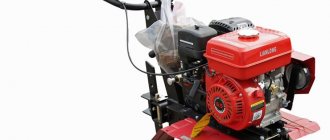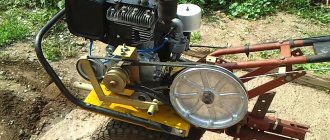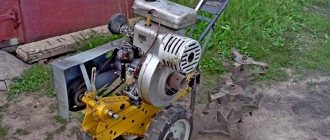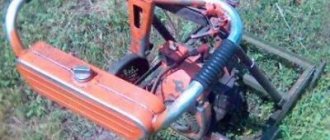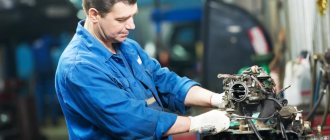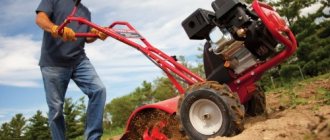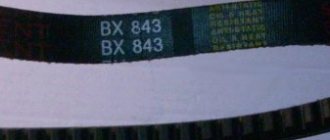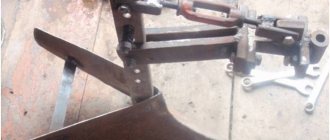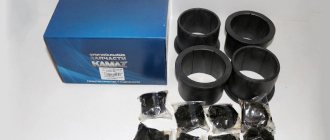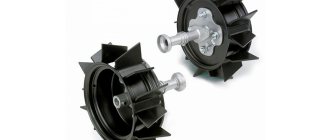Installation and running-in
In most cases, Chinese engines from Lifan are installed when the “native” motor has failed or has ceased to cope with its main task.
Of course, in such a situation, the new unit will come in handy. After purchase, such equipment will delight its owner for a long time with easy start-up and trouble-free operation. But you need to install the engine correctly for it to work efficiently.
Chinese-made engines are installed quite simply. Even a person who has never done this before can cope with this procedure.
Let's look at how to properly fix the Lifan engine with your own hands.
- First, remove the old device. This is done using special open-end wrenches or heads. It must be removed in its entirety, first unfastening the throttle cables, if they are included in the structure. Before directly removing the old unit, you will need to remove the belt working with the gearbox (transmitting torque to it).
- Now you can install the new engine. This is done using the same fasteners, if they match. But if not, then they will need to be redone by drilling holes or attaching auxiliary metal plates by welding or installing an adapter plate.
As for running in a newly purchased engine, different people’s opinions differ here. Some argue that the engine needs to be started immediately, and then run at half its declared power. Others advise letting the engine idle for a while to warm up properly. In reality, running in Lifan equipment should occur as described in the instruction manual.
It is not recommended to go beyond the scope of the instructions, because they are compiled by people with appropriate qualifications and experience. It is better to follow their recommendations so as not to spoil your new equipment.
In most cases, running in a new Lifan internal combustion engine (ICE) requires a lot of time. If you do everything based on the instructions, then no defects or malfunctions in the equipment will arise. If, with the correct actions, some problems do arise with the new engine (for example, kickback appears), then do not forget that it is sold with a guarantee.
Cost of repair and maintenance of 2-stroke Lifan engines
| Name of works | Price |
| Engine overhaul | 2500 rub. |
| Replacing the engine crankshaft | 2500 rub. |
| Cylinder replacement | 1500 rub. |
| Replacing oil seals | 1500 rub. |
| Replacing the piston | 1500 rub. |
| Replacing the piston ring | 1500 rub. |
| Replacing the spark plug | 100 rub. |
| Replacing the inlet pipe | 300 rub. |
| Flywheel replacement | 500 rub. |
| Replacing the flywheel key | 500 rub. |
| Replacing the clutch | 500 rub. |
| Replacing the clutch drum | 500 rub. |
| Replacing the clutch spring | 500 rub. |
| Replacing the pawl/spring | 300 rub. |
| Carburetor replacement and adjustment | 500 – 1200 rub. |
| Magneto replacement | 500 rub. |
| Muffler replacement | 200 rub. |
| Crankcase replacement | 500 – 900 rub. |
| Replacing the crankcase gasket | 500 – 900 rub. |
| Replacing the fuel primer | 100 rub. |
| Replacing the fuel tank | 500 rub. |
| Replacing the fuel hose | 200 rub. |
| Replacing the fuel line/filter | 300 rub. |
| Replacing the air filter | 100 rub. |
| Replacing the recoil starter | 500 – 1500 rub. |
| Replacing the starter spring | 500 rub. |
| Replacing the starter cord | 600 rub. |
| Replacing the ignition switch | 200 rub. |
| Recoil starter repair | 500 – 1500 rub. |
| Carburetor repair | 600 – 2500 rub. |
| Carburetor adjustment | 500 rub. |
| Adjusting the throttle cable | 100 rub. |
| Cleaning the fuel system | 600 – 800 rub. |
* The cost of our services may change after diagnostics of your equipment. We work with each client individually, which means the price is calculated in accordance with the level of complexity of a particular type of work.
We are responsible for the results of our work, confirming that our words do not differ from our deeds!
Types of walk-behind tractor engines
Gasoline and diesel engines are used for installation on gardening equipment and heavy agricultural equipment. The former are distinguished by high productivity and the ability to work in difficult operating conditions, the latter are versatile and economical. The walk-behind tractor engine, running on diesel fuel, supports a large number of types of attachments. The best production effect is achieved when operating at low speeds.
Such units have good motor life and are highly resistant to negative weather and climatic factors. The most popular are two-cylinder models. They are relatively inexpensive and tolerate elevated temperatures well. When using such a motor in the summer heat, a simple air cooling system will suffice. Gasoline modifications require high operating costs for maintenance, maintenance and operation. Their advantages are durability and reliability.
A four-stroke motor of this type has high performance and the ability to work on heavy soils. A unit equipped with a vertical shaft saves time because it can operate stably at high speeds. Power units compatible with walk-behind tractors are divided according to the starting method:
- to electric;
- for manual ones;
- to combined ones.
Manual drive is found in the most budget and outdated models. Units with electric start are more common, providing easy and quick start of equipment. They are economical, easy to use and reliable. Using an electric motor for a walk-behind tractor is appropriate at the dacha or in your own garden. The combined modification is a convenient option. 4-stroke engines designed for cultivating large areas of arable land and agricultural land are based on this functional scheme.
They greatly facilitate the operator’s task, since they allow you to choose a startup type that is convenient for you. Both petrol and diesel models are equipped with automatic speed control. Another classification feature is the power indicator. Engines up to 4 liters are installed on light walk-behind tractors (less than 70 kg). With. On medium ones (71-100 kg) motors up to 7 liters are used. With. To work together with heavy (over 100 kg) equipment, power units from 8 liters are used. With. The power limit is set at 16 hp. With.
Light and medium-sized walk-behind tractors use two-stroke gasoline or diesel engines with an air cooling system. They are well suited for household work in a private home. Among farmers, the most widespread are those equipped with a 4-stroke engine with a forced liquid cooling mechanism. Depending on the modification, the engine is equipped with a gear, chain or worm type gearbox. The latter can have a V-belt or bevel drive.
Fuel supply problems
Can't start the walk-behind tractor? The problem could be with both the engine and the ignition system. You should pay attention to the spark plugs. If they are still dry, there are problems with the fuel supply to the engine. Here are the main reasons for this phenomenon:
the fuel supply valve is closed;
there is no fuel in the tank;
clogged hole in the gas tank;
a foreign object has entered the fuel supply system.
You can eliminate these points as follows. Fill the gas tank, open the fuel tap, and clean the drain hole. Drain the gasoline from the tank, rinse it with clean fuel, and blow out the connecting hose and carburetor jets.
If fuel is supplied to the carburetor, but not to the internal combustion engine, in this case you will need to remove it, disassemble it, clean it and put it back in place.
Engine oil
When you have a walk-behind tractor as your assistant, you need to constantly monitor the technical condition. Oil is a very important component that needs to be changed on time. It is responsible in the unit for lubrication, sealing, cooling and cleaning of the motor components.
When the device operates in constant mode, the oil remaining in the cylinder may burn out and oxidize, as a result of which the walk-behind tractor begins to smoke. Also, substances with resins are deposited in the parts, which leads to contamination. Therefore, it is recommended to use good foreign lubricants that already contain the necessary additives.
Which engine is suitable for a walk-behind tractor?
The motor is one of the main elements of any mechanism and the efficiency of the entire device depends on it.
Typically the motor consists of:
- distribution mechanism;
- cylinder block;
- carburetor;
- ignition;
- starter;
- cooling systems.
Initially, DM66 and DM68 motors were installed on walk-behind tractors. But they often fail due to improper use, natural wear and tear, and other reasons, and therefore it is necessary to replace such a motor if it is not possible to restore it.
Lifan 168
One of the most common engines used for replacement is the Lifan 168. It has an engine capacity of 196 cubic centimeters and runs on gasoline. The power is 7 horsepower, air cooling, and therefore can only be used for a short time.
Installing the motor is simple and does not require any modification of the frame mounts.
Fluid replacement work is carried out as follows:
- with the engine turned off, unscrew the drain plug located on the pan;
- drain the oil from the system;
- tighten the plug;
- add new oil;
- warm up the engine;
- Check the level and top up if necessary.
B&S I/C
The B&S I/C engine, which belongs to modern models and is popular in domestic conditions, can also be installed. They are often used on Cascade units.
This is due to the following features of the motor:
- power 7 horsepower;
- reinforced transmission;
- enlarged combustion chamber;
- minimal noise during operation;
- high functionality even at low temperatures.
Vanguard OHV
The imported Vanguard OHV motor is also a powerful engine that can be installed on a walk-behind tractor from this manufacturer and cope with all the necessary tasks. This engine has a power of 7 horsepower.
Subaru EX17
You can also install the Subaru EX17 engine, which is popular among owners of Cascade walk-behind tractors. He has proven himself very well. It has a special design of the distribution mechanism inside and a large shaft diameter, which allows increasing engine power and efficiency.
As you can see, there are currently quite a lot of engines that can be installed on the Cascade walk-behind tractor. The choice of a suitable model depends not only on its functionality, but also on the financial capabilities of the owner.
It is also necessary to pay attention to the equipment, build quality and other points that are familiar to any motorist. If you don’t have the skills, you should always turn to specialists for help.
The engine must meet all requirements, which will allow it to operate efficiently and increase its service life.
Malfunctions of the walk-behind tractor engine during operation
The units and components of motors that are installed on mini-agricultural equipment are subject to significant loads. They can also fail during operation of the unit, which will very quickly lead to serious failures.
If you detect suspicious noises, jerks and disturbances in the operation of the walk-behind tractor systems, it is very important to immediately turn off the engine and then let it cool down - only after that will it be possible to fix the problem.
If during operation the motor begins to gain speed on its own, i.e. is “peddling”, most likely this means that the fastening of the regulator and thrust levers has become loose. In this case, the user will have to readjust the motor control drive.
Sometimes, when the throttle is fully open, the engine does not accelerate when the throttle is pressed, but rather begins to lose power until it comes to a complete stop. This is a clear sign of overheating, so you need to turn off the walk-behind tractor and wait until its components have completely cooled down. After this, you should check the oil level in the crankcase, and also check the cleanliness of the finned surfaces of the blocks and cylinder heads.
Under increased loads on the engine, it may seize. There may be several reasons for this:
- there is not enough oil in the crankcase;
- a nadir has formed on the lower head of the connecting rod;
- The connecting rod or oil sprayer has completely failed.
If the motor of a walk-behind tractor is jammed, you will have to disassemble it and check the condition of the main components and components: faulty, deformed, melted, etc. subject to replacement.
Video: Installing a Chinese Engine on a Cascade Motoblock
Lifan 168
One of the most widely used engines. Lifan 168. It has an engine capacity of 196 cubic centimeters and runs on gasoline. Power. 7 horsepower, air cooled, so they can only run for a short time.
To ensure the service life of the Lifan engine, after installing the Chinese engine, it is necessary to constantly fill in fresh oil and carry out maintenance.
Installing the motor is simple and does not require modification of the frame mount.
Fluid replacement work is carried out as follows:
- with the engine turned off, unscrew the drain plug located on the pan;
- drain the oil from the system;
- tighten the stopper;
- add new oil;
- warm up the engine;
- check the level and top up if necessary.
B.&S I/C
Motor B can also be installed.&S I/C, related to modern models and popular in everyday life. They are often used on cascade blocks.
This is due to the following engine features:
- 7 horsepower;
- enhanced transmission;
- enlarged combustion chamber;
- minimal noise during operation;
- high functionality even at low temperatures.
Vanguard ov
The imported Vanguard OHV engine is also one of the powerful engines that can be installed on the walk-behind tractor of this manufacturer and can perform all the necessary tasks. This engine has a power of 7 horsepower.
One refill is enough to work without a break for 4-5 hours.
Subaru EX17
You can install the Subaru EX17 engine, which is popular among owners of Cascade walk-behind tractors. It turned out great. It has a special camshaft design inside and a large shaft diameter to increase engine power and efficiency.
As you can see, at the moment there are quite a few motors that can be installed on the Cascade motor block. Choosing the right model depends not only on its functionality, but also on the financial capabilities of the owner.
It is recommended to purchase a motor based on the specific use of the machine to ensure longevity of the machine. Therefore, before purchasing, you need to understand the characteristics of the engine, consult with specialists and buy the best model.
It is also worth paying attention to the configuration, build quality and other points that are familiar to any car enthusiast. If you don't have the skills, you should always seek professional help
The engine must meet all requirements, which will allow it to operate efficiently and increase its service life.
Main problems of motors
Among the main failures of Cascade walk-behind tractors:
- The engine will not start;
- the engine runs intermittently.
The reasons for such malfunctions can be very different. from low-quality fuel to lit candles. Low battery may also be the cause. In this case, charge the battery and clean the fuel line or spark plug and replace it completely if necessary.
Another malfunction may be loss of the engine. The main reason in this case is a clogged carburetor or filter, which prevents the required amount of fuel from entering the combustion chamber. In this case, it is recommended to clean the system, since a return is possible when the engine starts.
Experts recommend periodically servicing this equipment to avoid such problems.
All of the above failures are quite rare, and if necessary, you can fix them yourself, no special knowledge is required. If you have problems with maintenance or repair, you can consult a specialist or receive instructions on how to use the network.
Attachments
To increase the functionality of the Cascade walk-behind tractor, the manufacturer installs mounts on it, with which you can perform various operations.
Among the most common pendants:
Cost of repair and maintenance of 4-stroke Lifan engines
| Name of works | Price |
| Engine overhaul | 2500 rub. |
| Replacing the engine crankshaft | 2500 rub. |
| Replacing the connecting rod and piston group | 2500 – 5000 rub. |
| Replacing the connecting rod | 500 – 2500 rub. |
| Replacing the piston | 500 – 2500 rub. |
| Replacing piston rings | 500 – 2500 rub. |
| Replacing crankshaft bearings | 1500 – 2500 rub. |
| Replacing valves | 1400 rub. |
| Replacing valve guides | 1000 – 1300 rub. |
| Replacing valve springs | 1400 rub. |
| Camshaft replacement | 2500 – 5000 rub. |
| Replacing valve stem seals | 1400 rub. |
| Replacing oil seals | 1500 – 2500 rub. |
| Replacing the ignition coil | 500 rub. |
| Replacing the spark plug | 100 rub. |
| Carburetor replacement and adjustment | 500 – 1200 rub. |
| Replacing the governor shaft | 1500 – 2500 rub. |
| Replacing the engine oil level sensor | 2500 rub. |
| Replacing the air filter | 100 rub. |
| Replacing the recoil starter | 500 – 1000 rub. |
| Replacing the flywheel key | 500 rub. |
| Replacing the fuel tank | 200 rub. |
| Recoil starter repair | 500 – 1500 rub. |
| Carburetor repair | 600 – 3500 rub. |
| Carburetor adjustment | 1200 rub. |
| Cleaning the fuel system | 1200 rub. |
